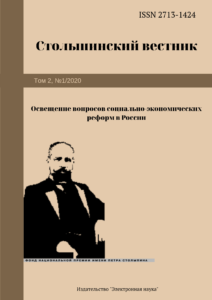Introduction
1.1. Publication of materials in peer-reviewed journals is not only a simple way of scientific communication, but also makes a significant contribution to the development of the relevant field of scientific knowledge. The journal sets standards of ethical behavior for all parties involved in the publication, namely: Authors, Editors of the journal, Reviewers, Publisher and the Scientific Community for the journal "Stolypinsky Vestnik"
1.2. The publisher not only supports and invests in scientific communications, but is also responsible for ensuring that the published work complies with all current recommendations.
1.3 The publisher undertakes to oversee the scientific materials. The articles published in the journal represent an impartial "report" of the development of scientific thought and research, therefore we also recognize the responsibility for the proper presentation of these "reports", especially in terms of the ethical aspects of publications set out in this document.
2. Duties of Editors
2.1. Decision to publish
The Editor of the scientific journal Stolypinsky Vestnik is solely and independently responsible for making publication decisions, often in collaboration with the relevant Scientific Society. The credibility of the work under consideration and its scientific importance should always underpin the decision to publish. The Editor may be guided by the policies of the Editorial Board of Stolypinsky Vestnik , but is constrained by such legal requirements as may be applicable to libel, copyright, legality, and plagiarism.
The Editor may confer with other Editors and Reviewers (or officers of the Scientific Society) when making publication decisions.
The Editor may request letters of recommendation from the academic council of the institution regarding the need to publish a highly specialized article.
2.2. Integrity
The editor should evaluate manuscripts for their intellectual content without regard to the race, gender, sexual orientation, religious beliefs, origin, citizenship, or political preferences of the authors.
2.3. Confidentiality
The Editor and the Editorial Board of the journal "Stolypinsky Vestnik" are obliged not to disclose information about the accepted manuscript to anyone except the Authors, Reviewers, potential Reviewers, other scientific consultants and the Publisher without necessity. The review is "blind".
2.4 Disclosure Policy and Conflicts of Interest
2.4.1 Unpublished data obtained from manuscripts submitted for review must not be used in personal research without the written consent of the author. Information or ideas obtained through peer review that may be beneficial must be kept confidential and not used for personal gain.
2.4.2 Editors should recuse themselves from considering manuscripts (i.e., ask a Co-Editor, Associate Editor, or collaborate with other members of the Editorial Board to consider the work instead of personally reviewing and making a decision) in case of conflicts of interest due to competitive, collaborative, or other interactions and relationships with Authors, companies, and, possibly, other organizations connected with the manuscript.
2.5 Publication oversight
An editor who has provided convincing evidence that the statements or conclusions presented in a publication are erroneous should notify the publisher (and/or the relevant learned society) so that corrections, retractions, expressions of concern, or other appropriate statements can be issued promptly.
2.6. Engagement and collaboration in research
The Editor, together with the Publisher (or the Society), will take appropriate response measures in the event of ethical complaints concerning manuscripts or published materials reviewed. Such measures generally include communication with
the Authors of the manuscript and the argumentation of the relevant complaint or request, but may also involve communication with the relevant organizations and research centers.
3. Responsibilities of Reviewers
3.1 Influencing Editorial Decisions
Peer review assists the Editor in making publication decisions and, through appropriate communications with the Author, may also assist the Author in improving the paper. Peer review is an essential part of formal scholarly communication and lies at the heart of the scientific approach. The Publisher shares the view that all scholars who wish to contribute to a publication have a responsibility to perform a substantial review of the manuscript.
3.2. Diligence
Any selected Reviewer who feels unqualified to review a manuscript or does not have sufficient time to complete the work promptly should notify the Editor of Stolypinsky Vestnik and request to be excluded from the review process for the manuscript in question.
3.3 Confidentiality
Any manuscript received for review must be treated as a confidential document. The work must not be shown to or discussed with anyone except as authorized by the Editor.
3.4. Requirements for the manuscript and objectivity
The reviewer must give an objective assessment. Personal criticism of the Author is unacceptable. Reviewers should express their opinion clearly and reasonably.
3.5 Acknowledgment of Sources
Reviewers should identify relevant published work that has not been cited in the manuscript. Any statement that an observation, derivation, or argument has previously been published should be accompanied by an appropriate citation. A reviewer should also call to the editor’s attention any substantial similarity or overlap between the manuscript under consideration and any other published work of which they have personal knowledge.
3.6 Disclosure Policy and Conflicts of Interest
3.6.1 Unpublished data obtained from submitted manuscripts must not be used in personal research without the written consent of the author. Information or ideas obtained through peer review that may be beneficial must be kept confidential and not used for personal gain.
3.6.2. Reviewers should not participate in the consideration of manuscripts in case of conflicts of interest resulting from competitive, collaborative, or other interactions or relationships with any of the Authors, companies, or other organizations connected with the submitted work.
4. Responsibilities of Authors
4.1. Requirements for manuscripts
4.1.1 Authors of articles reporting original research should present an accurate account of the work performed, as well as an objective discussion of the significance of the research. The data underlying the work should be presented accurately. The work should contain sufficient detail and references to permit reproduction. False or knowingly inaccurate statements constitute unethical behavior and are unacceptable.
4.1.2. Reviews and scientific articles must also be reliable and objective, the Editorial Board’s point of view must be clearly stated.
4.2 Access to and retention of data
Authors may be asked to provide additional data relevant to the manuscript for review by the Editors. Authors should be prepared to provide public access to such information (in accordance with the ALPSP-STM Statement on Data and Databases) where practicable, and in any event be prepared to retain such data for an adequate period of time after publication.
4.3. Originality and Plagiarism
4.3.1 Authors must ensure that the work they submit is original. If they use the work or statements of others, they must provide appropriate bibliographic references or excerpts.
4.3.2 Plagiarism can take many forms, from presenting someone else's work as your own, to copying or paraphrasing substantial portions of someone else's work (without attribution), to claiming the results of someone else's research. Plagiarism in all its forms is unethical and unacceptable.
4.4. Plurality, redundancy and simultaneity of publications
4.4.1 In general, an author should not publish a manuscript describing essentially the same research in more than one journal as original publication. Submitting the same manuscript to more than one journal simultaneously constitutes unethical publishing behavior and is unacceptable.
4.4.2. In general, an Author should not submit a previously published article for consideration in another journal.
4.5 Acknowledgment of Sources
Authors should cite publications that have been relevant to the conduct of the reported work. Information obtained privately, such as through conversation, correspondence, or discussion with third parties, must not be used or reported without explicit written permission from the source. Information obtained through confidential processes, such as manuscript review or grant applications, must not be used without explicit written permission from the author of the work involving the confidential sources.
4.6. Authorship of Publication
Authorship of a publication should be limited to those who have made a significant contribution to the conception, design, execution, or interpretation of the reported research. All those who have made significant contributions should be listed as co-authors. Where study participants have made significant contributions in specific areas of the research project, they should be listed as significant contributors to the study.
4.7. Material and gross errors in published works
After the article is published on the journal's website, if the Author discovers material errors or inaccuracies in the publication, the Author must notify the Editor of the journal "Stolypinsky Vestnik" and cooperate with the Editor to correct the errors as soon as possible. Making editorial corrections is considered an additional editorial service and is paid for by the author.
If the Editor or the Publisher receives information from the Author or a third party that the publication posted in the RSCI contains significant errors, there are significant borrowings from other sources (more than 25% plagiarism), the editors decide to withdraw the work (retraction) as soon as possible. In these cases, the cost of the editorial services provided is not refunded. The editors do not provide services for making edits to the article posted in the RSCI.
5. Responsibilities of the Publisher
5.1 The Publisher follows principles and procedures that facilitate the fulfillment of ethical responsibilities by Editors, Reviewers and Authors of the journal "Stolypinsky Vestnik" in accordance with these requirements.
5.2. The Publishing House provides support to the Editors of the Stolypinsky Vestnik journal in considering complaints about the ethical aspects of published materials and helps to interact with other journals and/or Publishing Houses if this facilitates the performance of duties by the Editors.













